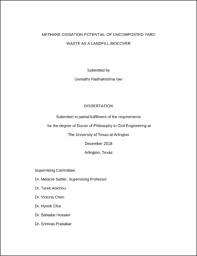
ATTENTION: The works hosted here are being migrated to a new repository that will consolidate resources, improve discoverability, and better show UTA's research impact on the global community. We will update authors as the migration progresses. Please see MavMatrix for more information.
Show simple item record
| dc.contributor.advisor | Sattler, Melanie L | |
| dc.creator | Radhakrishna Iyer, Gomathy | |
| dc.date.accessioned | 2021-01-12T17:38:31Z | |
| dc.date.available | 2021-01-12T17:38:31Z | |
| dc.date.created | 2018-12 | |
| dc.date.issued | 2018-12-18 | |
| dc.date.submitted | December 2018 | |
| dc.identifier.uri | http://hdl.handle.net/10106/29682 | |
| dc.description.abstract | Biocovers are widely used in landfills to oxidize emissions of the greenhouse gas methane. Biocovers used till date are fully or partially made of composts. Compost takes time and effort to create, and costs about $10 per cubic yard on an average. Even more importantly, however, production of compost, although theoretically an aerobic process, actually generates methane, from 3.2 to 362 kg CO2-equivalents per ton of wet waste composted, depending on the type of waste, whether open or enclosed composting technology is used, and other factors.
To reduce the net greenhouse gas emissions from biocovers, this research explores the potential of uncomposted yard waste as a landfill biocover to oxidize methane. The components of yard waste were separated as grass clippings, leaves, and mixed yard waste and physical and chemical characteristics were analyzed. The characteristics of biosolids and different fly ashes were also analyzed with the intention of biosolids helping the yard waste in enhancing the microbial community and nutrients, and fly ash helping in keeping the yard waste compact. These materials by themselves and in combination were tested in batches for methane removal.
The grass clippings and a mixture of grass, biosolids, and fly ash showed the highest performance in batch tests were further tested in columns which replicated landfill conditions. The biocover performance index for the uncomposted grass, biosolids & fly ash biocover mixture was 43.3 µg/g/hr vs. 29.0 for a traditional compost biofilter. Also, upon biological analysis of column reactor samples, presence of methanotrophs were confirmed in both grass and biocover mixture. However, upon analyzing the leaching characteristics of fly ash, it was found there is leaching of silver, arsenic, cadmium, chromium and thallium greater than the permissible limit in drinking water. This study therefore suggests using of grass and biosolids as biocover mixture to remove methane emissions from landfills. | |
| dc.format.mimetype | application/pdf | |
| dc.language.iso | en_US | |
| dc.subject | Biocover | |
| dc.subject | Landfill | |
| dc.subject | Waste diversion | |
| dc.title | METHANE OXIDATION POTENTIAL OF UNCOMPOSTED YARD WASTE AS A LANDFILL BIOCOVER | |
| dc.type | Thesis | |
| dc.contributor.committeeMember | Abichou, Tarek | |
| dc.degree.department | Civil Engineering | |
| dc.degree.name | Doctor of Philosophy in Civil Engineering | |
| dc.date.updated | 2021-01-12T17:38:32Z | |
| thesis.degree.department | Civil Engineering | |
| thesis.degree.grantor | The University of Texas at Arlington | |
| thesis.degree.level | Doctoral | |
| thesis.degree.name | Doctor of Philosophy in Civil Engineering | |
| dc.type.material | text | |
| dc.creator.orcid | 0000-0002-0908-5632 | |
Files in this item
- Name:
- RADHAKRISHNAIYER-DISSERTATION- ...
- Size:
- 4.711Mb
- Format:
- PDF
This item appears in the following Collection(s)
Show simple item record


